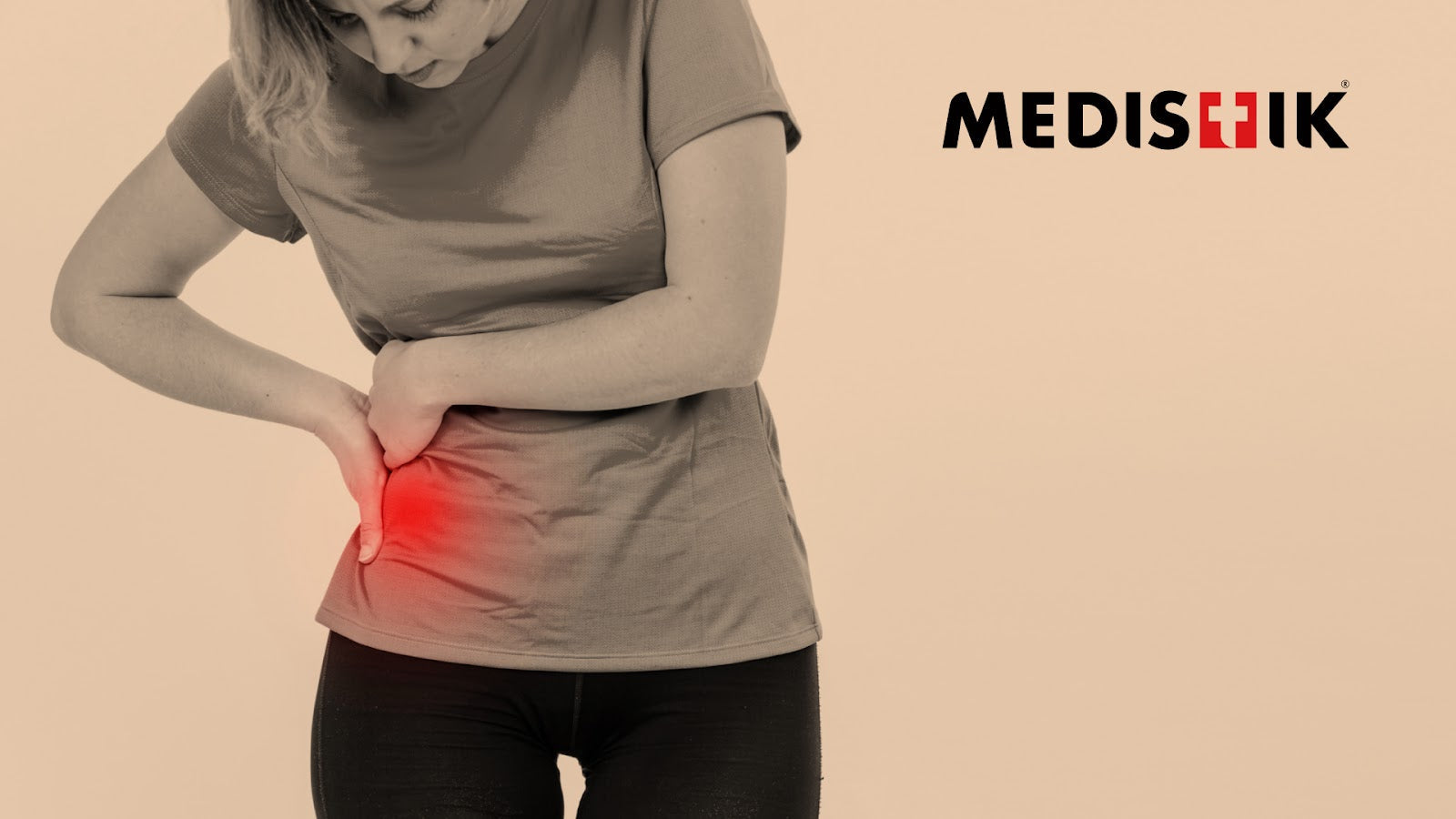Hip Flexor Pain 101: Understanding Causes, Symptoms, and Treatment Options

Hip flexor pain is a common experience for many people, and it can impact your mobility and cause discomfort. Hip flexor pain can happen to us all, regardless of whether you sit in an office chair all day or are a pro-athlete. Understanding the causes and symptoms of hip pain or tight hip flexors is important to ensure you are using the correct treatment options. Read on for your ultimate guide to hip flexor pain.
Where is hip flexor pain felt?
Your hip flexors are a group of muscles located in front of your hip, whose primary goal is flexing the hip joint, which allows for leg movements, and bending at the waist. The five key muscles for hip flexion where you might feel pain in are:
-
Iliacus: helps in bending the hip and stabilizing the pelvis
-
Psoas major: essential for bending or lifting the legs
-
Pectineus: aids with movements that require the thigh to move inward, like squatting
-
Rectus femoris: holds a dual role helping with both hip flexion and knee extension
-
Sartorius: helps with movements that require flexion and rotation
These muscles are essential for everyday movements such as walking, climbing stairs, running, and squatting[1]; so it’s crucial you maintain healthy hip flexors.
Below is a Hip Pain Location Diagram that might help you better understand the source of your hip flexor pain:

Common Hip Flexor Pain Causes
If you are experiencing pain in your hip flexors, it could be due to multiple reasons based on your age, activity levels, and any recent accidents or injuries you may have experienced.
Hip flexor pain from overuse or strain
Hip flexor pain can happen when the muscles in front of your hip are overused or strained due to repetitive movements or prolonged activity. Working out or exercising, especially running[2], can be a major factor in hip flexor pain. Being improperly warmed up or suddenly increasing your activity levels can contribute to hip flexor strain. Conversely, people who sit for extended periods of time, like in an office job[3], can also experience hip flexor pain which can lead to stiffness in the hip or groin.
Posture issues causing hip flexor pain
Hip pain can be caused by bad or poor posture putting extra strain on the muscles in front of the hip. Sitting all day with poor posture like a titled pelvis or slouching can cause the hip flexors to become tight, which can lead to pain. Over time poor posture forces your hip flexor muscle to work harder, which can cause discomfort and stiffness.
Injury or trauma to the hip flexors
If you’ve experienced a sudden or intense movement, or an accident like a trip or a fall, you may have injured your hip flexors. Events like these can cause strains or tears to your hip flexor muscles. Injuries and trauma to the hip flexors can lead to a sharp pain, swelling in the hip area, difficulty moving the leg, and a reduced range of motion.
Age-related factors causing hip flexor pain
There are also natural age-related reasons why you may be experiencing hip flexor pain[4]; as we age, your hip flexors tend to lose flexibility and strength. The reduced muscle function can lead to tightness in the hip area, making it more difficult and painful to bend over, or lift your legs.
Symptoms of hip flexor pain
Your hip flexor pain may present differently based on numerous factors. Look out for these symptoms of hip flexor pain
-
Pain in the front of the hip, groin, or upper thigh
-
Dull aches
-
Sharp, stabbing pain
-
Difficulty bending over or lifting legs
-
Swelling or bruising
-
Stiffness in the hip
If your symptoms continue or worsen, seek professional medical advice.
Treatment options for hip flexor pain
There are some at-home treatment options for hip flexor pain that you may want to explore. Make sure you always check with a medical professional to see if these treatments are right for you.
Rest and ice for hip flexor pain
If you’re experiencing hip flexor pain, rest and ice should be your first treatment options. Rest and ice is an effective treatment, as rest allows the body to heal while applying ice helps reduce inflammation and provide a numbing relief. Apply an ice pack wrapped in a cloth for 15-20 minutes at a time, several times a day.
Stretching exercises for hip flexor pain
You can stretch your hip flexors easily at home to help release tension and reduce pain. Some easy stretches for hip flexor pain you can try include:
-
Passive Pendulum Swing – A gentle hip mobility exercise to loosen tight hip flexors.
-
Bridge Pose Stretch – A stretch that activates the glutes while relieving hip flexor pain.
-
Massage Ball Release – A deep tissue technique to target hip tension and reduce pain.
LEARN MORE ABOUT HIP STRETCHING EXERCISES
Strengthening exercises for hip flexor pain
Alongside stretching, it’s important to incorporate some strengthening exercises into your mobility routine. Some at home exercises for hip flexor pain include:
-
Sitting Leg Raises – Isolates hip flexors to build strength without compensating with other muscles.
-
Dead Bug Core Activation – Engages the core and hip flexors for better stability and injury prevention.
-
Standing Knee Raises – A simple yet effective hip mobility exercise to activate and strengthen the hip flexors.
LEARN MORE ABOUT HIP FLEXOR STRENGTHENING EXERCISES
Physical therapy for hip flexor pain
Physical therapy can be a useful tool for treating and preventing hip flexor pain. Like any other muscle group, your hip flexors can be stretched and soothed to provide relief, and strengthened over time to prevent pain recurring.

Over-the-counter medications
Over the counter, or OTC medications like ibuprofen or acetaminophen can provide short-term relief from hip flexor pain. OTC medications can help reduce the pain signals you are experiencing, and reduce inflammation in the impacted area. Some OTC medications carry side effects and may not be suitable for you, so ensure you check with your doctor to see if these pain relief medications are recommended for you.
Topical pain relief for hip flexor pain
Hip flexor pain or tight hip flexors may be eased with the use of a topical pain relief treatment, like MEDISTIK. Topical pain relief like MEDISTIK blocks the enzymes that cause inflammation, and can help dilate blood vessels, increasing oxygen to the site through increased blood flow, leading to less pain in your hip flexors.
“I love prescribing MEDISTIK to my clients for home care. If you've been training for a marathon or doing your active daily life and you're feeling some pain and tension, this is a great tool to get you through to your next treatment.”
- Aimee Sutton, Owner of Well Daze, RMT and CIMT
How to prevent hip flexor pain
Once you’ve treated your hip flexor pain, you should ensure that you are taking steps to prevent the pain from returning. Some easy tips you can do at home are:
-
Ensure proper posture: maintain neutral pelvis alignment and good posture while sitting, standing, and walking.
-
Regular stretching: incorporate hip flexor stretches into your routine to keep your muscles flexible.
-
Strengthen surrounding muscles: strengthen your glutes, hamstrings, and core to support the hip flexors.
-
Avoid overuse: avoid repetitive activities and take breaks regularly from sitting.
Conclusion
Understanding the causes, symptoms, and treatments of your hip flexor pain can make the world of difference in your daily life, alongside topical pain relief treatments like MEDISTIK. Practicing stretching and strengthening exercises, alongside avoiding overuse and strain, can help prevent your hip flexor pain from recurring. Consult a professional if your pain persists.
At MEDISTIK, we adhere to strict sourcing guidelines and rely on peer-reviewed studies, reputable academic research institutions, and trusted medical organizations. We use only credible, high-quality sources to ensure our content is accurate, reliable, and trustworthy. Learn more about how we maintain content accuracy and integrity by reviewing our editorial process.
- Physiopedia ( n.d.) Hip Flexors. https://www.physio-pedia.com/Hip_Flexors. Accessed 03/10/2025.
- Niemuth PE, Johnson RJ, Myers MJ, Thieman TJ. Hip muscle weakness and overuse injuries in recreational runners. Clin J Sport Med. 2005 Jan;15(1):14-21. doi: 10.1097/00042752-200501000-00004. PMID: 15654186.
- Boukabache A, Preece SJ, Brookes N. Prolonged sitting and physical inactivity are associated with limited hip extension: A cross-sectional study. Musculoskelet Sci Pract. 2021 Feb;51:102282. doi: 10.1016/j.msksp.2020.102282. Epub 2020 Oct 28. PMID: 33188982.
- Anderson DE, Madigan ML. Healthy older adults have insufficient hip range of motion and plantar flexor strength to walk like healthy young adults. J Biomech. 2014 Mar 21;47(5):1104-9. doi: 10.1016/j.jbiomech.2013.12.024. Epub 2014 Jan 10. PMID: 24461576; PMCID: PMC3975833.
Written by Aimee Sutton, RMT, CIMT in Collaboration with Dr. Kevin Kraemer, B.Sc., B.App.Sc (Chiropractic)
Written by Aimee Sutton, RMT, CIMT in Collaboration with Dr. Kevin Kraemer, B.Sc., B.App.Sc (Chiropractic)
Aimee Sutton is a seasoned RMT & CIMT Expert with 17+ years in clinical and holistic care experience. Aimee’s approach is grounded in identifying and addressing the root causes of pain, rather than just the symptoms. Specialization includes hip pain, soft tissue injuries and chronic pain.
Dr. Kevin Kraemer is a highly skilled chiropractor with extensive experience in chronic pain management and sports medicine. He is experienced in a wide range of pain conditions including back pain, spinal health, joint discomfort, sport injuries and mobility challenges.

Medically Reviewed By: Dr. Celia Pires, BPHE, B.Sc., D.C.
Medically Reviewed By: Dr. Celia Pires, BPHE, B.Sc., D.C.
Dr. Celia Pires is a leading chiropractic doctor and the Director of St. Clair West Chiropractic & Wellness Clinic in Toronto. With over 25 years of experience, she specializes in sports injuries, spinal health, rehabilitation, and pre/post-natal chiropractic care.
Related Posts
-
![]() Pain Management
Pain ManagementWhat is the Treatment for Sacroiliac Joint Pain?: Ask The Experts
Hip flexor pain is a common experience for many people, and it can impact your mob...4 Min. To Read -
![]() Pain Management
Pain ManagementWhat is the Best Painkiller for Knee Pain?: Ask The Experts
Hip flexor pain is a common experience for many people, and it can impact your mob...4 Min. To Read
 - FREE SHIPPING ON ORDERS $50+
- FREE SHIPPING ON ORDERS $50+

 - FREE SHIPPING ON ORDERS $40+
- FREE SHIPPING ON ORDERS $40+











